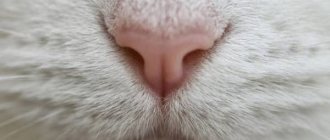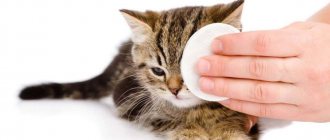Victoria Rashidovna Khazimulina
veterinarian Petstory
If a cat pees with blood, then you should show him to a doctor as soon as possible. This symptom is called hematuria and can be a sign of serious diseases of the urinary system (UUS) and genitourinary systems (GUS). Blood in a cat's urine may be visible to the naked eye (gross hematuria). Or it may be unnoticeable (microhematuria), then the urine becomes a little darker, but not red.
Blood in urine in cats: the main thing
- Hematuria is a good reason to take your cat to the veterinarian.
- The main reason for the appearance of blood in the urine of a cat is diseases of the urinary and reproductive systems, as well as injuries.
- Frequent accompanying symptoms: frequent and painful urination, discharge, pain in the bladder area.
- Castration has little effect on the frequency of symptoms. Blood in the urine can occur in both a regular cat and a sterilized one.
- Diagnosis depends on the medical history, most often requiring a urine test and ultrasound.
- Treatment is complex and should be aimed at the cause of the disease.
- If a cat is peeing blood, first aid can be provided at home, but you should first consult a veterinarian.
- Prevention includes a balanced diet, drinking regime, a high level of activity and timely castration/sterilization if the pet is not used for breeding.
Preventing common urinary problems in cats
Feline urological syndrome (FUS), as the condition is sometimes called, refers to a spectrum of different conditions that cause urinary problems in furry friends, explains the Cornell Feline Health Center. The reasons for the development of these conditions and methods for their treatment still remain not fully understood. There are two main categories of preventive measures to prevent your cat from developing lower urinary tract disease (FLUTD).
- Environment and stimulation. A cat's life may seem easy and enjoyable, but animals with signs of lower urinary tract disorders may disagree. Cats with urological syndrome are prone to developing stress and require a little more care than most of their cats. Having a choice of places to play, rest, eat and litter will help minimize stress for your cat. For example, each pet should have access to a private sitting area, scratching posts and toys. Cats that are prone to stress often sit on elevated surfaces to monitor their surroundings. Provide a personal litter box for each cat and one additional one. Daily cleaning of the litter box is important for many cats with urological syndrome, as indeed for all other cats. Pets do not like to use a dirty litter tray and, accordingly, can find a cleaner place for their “business” that is less desirable for the owner.
- Proper nutrition and sufficient water in the daily diet. The most important ways to prevent signs of lower urinary tract disorders are to eat a healthy diet and drink enough water. Feeding your cat wet food is the main way to increase her overall fluid intake. Another way to encourage your cat to drink more is to install a fountain with circulating water, place several bowls of water in different places in the house, or perhaps the cat will like to drink water directly from the tap. If your cat drinks enough water, its urine will be less concentrated, which will prevent the formation of crystals, which are the building blocks for uroliths.
It is important to make sure that the cat is eating a complete, balanced food appropriate for its stage of life, and not “all at once.” Some foods contain excess minerals, which can contribute to the formation of crystals and uroliths and, consequently, the development of lower urinary tract diseases.
Although urological syndrome occurs quite often in cats, you should not limit yourself to your own assumptions if a cat walks around with blood. You must immediately seek veterinary help in order to figure out what’s wrong with your pet as quickly as possible and begin the necessary treatment. It is important to remember that acute urinary retention poses a threat to the animal's life and requires emergency medical attention.
Causes of blood in cats urine
If a cat goes to the toilet with blood, this may indicate the following diseases:
- Urocystitis (inflammation of the bladder);
- Urolithiasis disease;
- Inflammatory kidney diseases;
- Injuries (fall, blow, surgery);
- Diseases of the prostate gland in males (prostatitis, hyperplasia);
- Balanoposthitis – inflammation of the penis;
- Orchitis – inflammation of the testes;
- Diseases of the reproductive system in females (endometritis, vaginitis, ovarian cysts, etc.).
What to do if blood appears in the urine: treatment at home
In severe situations, when bleeding threatens life, or calculi (stones) clog the lumen of the excretory canals and block the outflow of urine, surgery is performed in the clinic. In most cases, the animal owner takes part in treating the pet at home, following the orders of the veterinarian.
The therapeutic strategy is based on diet therapy and drug treatment.
Diet therapy
If a cat pees in blood, then proper nutrition cannot be avoided for the following reasons:
- It is necessary to maintain average fatness. Cats that do not walk outside, especially sterilized ones, are prone to overeating with reduced physical activity. Boredom causes them to develop an appetite. In obese pets, metabolism slows down, fat puts pressure on the urinary organs, urine stagnates, which contributes to the attachment of microbes to the wall of the bladder, as well as the precipitation of urinary salts.
- Economy class feeds and natural products are unbalanced in protein. They have a low concentration of energy, little dietary fiber and vitamins. A significant part of the defective protein is not digested and is converted into uric acid. Nitrogenous slag is poorly soluble in water, is prone to precipitation and is a breeding ground for microbes.
- In animals predisposed to urolithiasis, 2 types of stones form. Phosphorus-rich struvite forms in alkaline urine. In acidic urine, oxalates—calcium salts and oxalic acid—precipitate. The veterinarian conducts a urine test, makes a diagnosis, based on which he recommends the use of specialized medicinal food.
Be sure to read:
The kitten has bad breath: reasons, what to do, when it is an alarming symptom, prevention
Depending on the presence of stones and the patient’s condition, the following veterinary feeds are used:
- Purina UR for urolithiasis;
- Hill's Metabolic + Urinary for weight loss and struvite dissolution;
- Eukanuba Urinari Oxalate;
- Eukanuba Urinari Struvite;
- Royal Canin Neutered Adult Maintenance for the prevention of urolithiasis and obesity in sterilized cats.
Medicines and folk remedies
Veterinarians prescribe complex remedies. The drug Stop-cystitis in tablets or suspension contains the antibiotic nitroxoline and the antispasmodic drotaverine, which inhibit pathogenic microflora, relieve spasms and relieve pain.
Most of the drugs popular in the treatment of diseases of the urinary canal, kidneys and bladder are produced on the basis of traditional medicine and are a mixture of extracts of medicinal herbs.
The following herbal remedies are popular:
- Stop Cystitis Bio;
- Erwin the cat;
- Phytodoc Nefrospas;
- Urolex;
- Urinari tract support.
Associated symptoms
With different pathologies, various accompanying symptoms will appear.
Thus, urocystitis and urolithiasis are characterized by:
- Pollakiuria (frequent urination);
- Periuria (uncleanliness);
- Excessive licking of the groin area;
- Staying in the tray for a long time.
With urolithiasis, in addition to the fact that the cat pees with blood, there is a periodic inability to urinate (urethral blockage).
For kidney inflammation:
- General malaise, lethargy;
- Fever;
- Decreased appetite;
- Acute pain in the entire abdominal wall;
- Prolonged, painful urination;
- Cloudy or pink urine.
In case of injury:
- Acute tissue pain at the site of impact;
- Hematomas, abrasions.
Prostate diseases are characterized by:
- Painful, prolonged urination;
- Changing posture when urinating;
- Uncleanliness;
- Discharge from the prepuce;
- Inability to urinate;
- Much more common in uncastrated animals.
If a cat has diseases of the reproductive system, blood may appear in the urine for two reasons. First, inflammation of the uterus or vagina can trigger inflammation of the bladder (urocystitis). After all, the urethral canal is in close contact with the vagina. Secondly, vaginal discharge (with blood) can get into the urine from the outside when the cat pees.
Symptoms:
- Violation of the reproductive cycle, frequent estrus;
- Vaginal discharge;
- Excessive licking of the groin area;
- Increased thirst;
- Fever;
- Increased abdominal volume;
- Lethargy, drowsiness;
- Decreased appetite;
- Mastitis (inflammation of the mammary glands).
Balanoposthitis in a cat, in addition to hematuria, manifests itself:
- Hyperemia (redness) of the penis;
- Excessive licking of the groin area;
- Discharge from the prepuce;
- Prolonged, painful urination.
Orchitis can only occur in uncastrated males. The urethra connects to the vas deferens, so if there is blood in the semen, it will appear in the cat’s urine from time to time.
Characteristics of orchitis:
- Swelling and tenderness of the testis/testes;
- Cats that are sexually active are susceptible;
- The frequency of urination may not change.
What to do if your cat is peeing blood?
If it is not possible to immediately contact a veterinarian if blood is detected in the urine, provide first aid to your pet. When carrying, be as careful as possible, especially if the cat has recently been sterilized or has been injured.
Your actions:
- Provide peace . Don't let your pet go outside. Place him in a warm and quiet place where he feels comfortable and safe;
- Don't give him drugs . Do not self-medicate. Any mistake with the dosage or method of administration will lead to irreversible consequences;
- Nutrition . Eliminate dry and solid food from your cat's diet. Ensure constant availability of fresh water.
Do not hesitate to visit the veterinarian - contact him as soon as possible.
Features of castrated cats
If the cat is neutered, then with a high degree of probability we can exclude such diagnoses as prostatitis and orchitis. Previously, it was believed that neutered cats are more likely to suffer from MBC diseases. However, statistics refutes this fact. But why are neutered cats considered more at risk?
The main reason is mobility. Testosterone, which is mostly produced by the testes, is no longer supplied in the same quantities, which leads to changes in metabolism. No, the cat will not become a “vegetable” after castration, because the hunting instinct will not go away, but it will move a little less, and its appetite will most likely increase. Reduced activity and overeating leads to weight gain, and subsequently to the formation of sand and stones.
Hurry up, choose a box and find out what gift awaits you
Discount on pet insurance
Promo code copied to clipboard
Prevention
Prevention of hematuria in cats is based on proper, balanced feeding, because One-sided feeding leads to metabolic disorders with all the ensuing problems. Cats benefit from the inclusion of fermented milk products in their diet as a source of calcium. Provide your cat with an active lifestyle to improve its metabolism. Never overfeed your pet because... obesity leads to a large number of metabolic diseases. Treat against helminthic diseases twice a year.
Diagnostics
To diagnose urocystitis and urolithiasis you will need:
- General urine analysis;
- Ultrasound of the bladder;
- BAC urine culture (not always);
- X-ray of the abdominal cavity (if urolithiasis is suspected).
For kidney inflammation:
- General urine analysis and protein/creatinine ratio in urine;
- Blood biochemistry;
- Ultrasound of the urinary system;
- BAK urine culture (not always).
For injuries:
- Ultrasound of the abdominal cavity;
- X-ray of the abdominal cavity;
- Clinical blood test.
For prostate diseases and orchitis:
- General urine analysis;
- Ultrasound of the genitourinary system;
- BAK urine culture (not always).
For diseases of the reproductive system in females:
- Ultrasound of the genitourinary system;
- General urine analysis.
For balanoposthitis:
- General urine analysis;
- Deep smear cytology;
- Ultrasound of the genitourinary system;
- TANK culture (not always).
Conditions in which hematuria occurs
Hematuria develops in a number of diseases:
- inflammatory diseases of the urinary system: pyelonephritis (inflammation of the renal pelvis);
- cystitis - inflammation of the mucous membrane of the bladder;
- urethritis - inflammation of the urethra (urethra); In addition to hematuria, in inflammatory diseases the following is noted: pain syndrome (in pain, the cat hunches its back);
- painful and frequent urination;
- fever;
- decreased activity and appetite in the cat;
- deterioration of general health;
The list of diseases that manifest as hematuria is extensive. For correct diagnosis and prescription of therapy, medical assistance is necessary, as well as the possibility of conducting additional research. Self-diagnosis and self-medication will not lead to success and will worsen the prognosis of the disease. Before visiting the clinic, to alleviate your pet’s condition, you need to:
- give the cat complete rest;
- place the cat in a warm room on a bedding, avoid drafts;
To alleviate the cat's condition, you need to provide her with warmth and peace.
- feed only liquid, easily digestible food, do not give solid foods;
- provide plenty of water to drink;
- drink decoctions of juniper fruits, horsetail herbs, bearberry, parsley root;
- give an intramuscular injection of No-shpa 1–2 mg per kg of cat weight.
Baralgin is often recommended to relieve pain in a cat, but at the stage of first aid, when the diagnosis is still unclear, it should not be used. In addition, due to belonging to the group of non-steroidal anti-inflammatory drugs, Baralgin can contribute to the continuation of hematuria. The exact dose of Baralgin, as well as the need for its use, will be determined only by a doctor. The best help for an animal is immediate delivery to the clinic.
The best first aid for a cat with hematuria is its immediate delivery to the clinic.
Treatment of hematuria
For the treatment of urocystitis, urolithiasis, nephritis, the following measures and groups of drugs are used:
- Antispasmodics;
- Painkillers;
- Drink plenty of fluids;
- Antibiotics (not always).
In case of urolithiasis, specialized diets and drugs that affect the pH of urine are additionally used.
For nephritis, intravenous infusions and several groups of antimicrobial drugs can be used simultaneously.
If your cat pees blood after an injury, you will need:
- Limited mobility;
- Painkillers;
- Hemostatic;
- Surgery may be required (for example, if the wall is torn).
For diseases of the reproductive system in cats, the following are used:
- Painkillers;
- Antispasmodics;
- In males, antihypertensive drugs that relax the urethra;
- Antibiotics;
- Operation (castration).
If a prompt visit to the veterinarian is not possible
If a cat is peeing with blood, the first thing you need to do is to provide the pet with peace. Set up a bed for him in a quiet, warm place, surround him with care. Place several bowls of fresh water near your pet.
Under no circumstances should you give medications from a human first aid kit without a doctor’s recommendation. First, many drugs cannot be used in animals. Secondly, dosages are completely different for cats and humans. Thirdly, many drugs have contraindications for use.
To properly provide first aid to your pet while you are unable to take it to the clinic, you can consult with a veterinarian online in the Petstory mobile application. The doctor will collect a detailed history, recommend how to help your pet at the moment, tell you what diagnostics should be carried out and what could be the reason for the appearance of red urine in your cat. You can download the application from the link.
Treatment
Treatment of hematuria is based on the identified cause and takes into account the individual characteristics of the animal. In most cases, this includes taking pain medications, developing a healthy diet, increasing water intake, prescribing antispasmodics to relax the bladder, fluid therapy, and reducing stress.
If a cat is diagnosed with urethral obstruction, the veterinarian will take measures to alleviate the animal's condition. To do this, he will install a special catheter in the urethra, after first calming the pet or administering anesthetic drugs.
Antibiotics are used to treat infections. Urinary stones are removed surgically, or the cat is prescribed a special diet.
Manifestations of hematuria
Cats' urine is normally clear with a pale yellowish-orange tint. In the first stages of the pathology, the symptom is mild. Urine is slightly shaded. The color changes depending on the level of red blood cells. The redder the urine, the more blood cells it contains.
© shutterstock
Sometimes even small blood clots are visible in the urine. This happens very rarely. Such symptoms indicate an advanced stage of the disease. To control, it is best to choose a light filler for the tray and each time look to see if the color of the urine changes (or intensifies) in the red direction. Sometimes it is impossible to notice changes visually, only with the help of laboratory tests.
Types of hematuria
Hematuria is divided into several types, depending on the causes:
- Diseases of the urinary system. The causes are various infections in the area of the ureter, bladder, and urethra. The development of pathologies can be triggered by bacteria, injury to internal organs, neoplasms or major inflammatory processes.
- Hematuria as a consequence of a systemic disease. In this case, the urine turns red or pink. It appears against the background of diseases of the cardiovascular system, kidneys, and excessive physical overload. Hypothermia or overheating can also be causes.
- Renal parenchymal is a consequence of impaired renal function. This provokes various anomalies of different organs, inflammation, injury or infection.
- Diseases of the genital tract are accompanied by the release of dark urine. In cats, this occurs due to inflammation of the prostate.
Treatment should in any case be carried out strictly under the supervision of a doctor.











